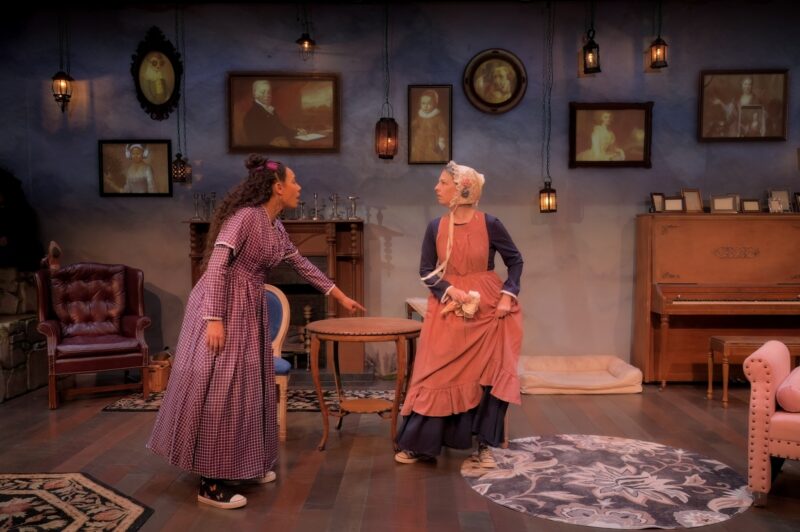You Never Know What Can Happen on The Moors
Review of The Moors at Seattle Public Theater
Written by TeenTix Newsroom Writer Kaylee Yu and edited by Teen Editorial Staff Member Kyle Gerstel

Two spinster sisters sit in the parlor of their ancestral mansion. The mastiff, with his drooping jowls, pants rhythmically atop a brocaded carpet. The windows let in the weak light from the endless gray sky of the Moors; the maid Marjorie (or is it Mallory? Margret?) coughs and complains that their company is late. A governess, fresh-faced from London, arrives today.
Walking into Seattle Public Theater (known affectionately as “The Bathhouse”), the intimate, public-bathhouse-turned-blackbox-theater is filled with soft, slightly ominous piano music. On the stage is a dark sitting room, where antique, dark tones are counterbalanced by a millennial-pink velvet sofa. The moody set is a perfect, yet slightly quirky, canvas for a period piece—so long as you can ignore the paintings donning sunglasses and the converse-clad cast. Highlights in hair and pom-pom pens abound.
This subversion of the typical Victorian aesthetic also permeates the meat of the play. Inspired by Austen and the Brontë sisters, playwright Jen Silverman hones in on what we love most about period dramas. Themes of family, true love, and home weave together… but not in the way you’d expect. In this home, small-town domesticity, sisterly love, and familial loyalty are replaced by secrets, twisted romance, and murderous intent, filling the manor like the rising tide. Horror and awe build in audience members’ stomachs, a weight that drags us under the water. And so, we drown.
After all, one is not coddled by the Moors.

Ever-present and ever-silent, the Moors are the main players here. Filling the stage with its intent, the savage, deadly environment is quite unlike any we know. In the abstract, absurdist play, time seems relative; space is whatever the characters label it. The sitting room is also Agatha’s bedroom, or the dining room, or maybe the study? The possibly confusing spatial relativity is handled wonderfully, adding to the offbeat, ominous cloud cast over the stage. And on the Moors, it is always overcast. Quicksand swallows the weak, and the wind and rain toughen the strong, and, as always, the birds fall from the sky and die. As eldest sister Agatha flippantly puts it, “we contend with savagery.”
The characters are children of the Moors, reflecting their nature. The officious, imposing, and often cruel Agatha (Lisa M. Viertel) runs the household with an iron fist. She barks more than the mastiff, and she’s as dark and uncompromising as the Moors themselves. In contrast, bubblegum pink-wearing little sister Huldey (Megan Ahiers) might pass for sweet— if you can ignore her desperate loneliness, her main character complex, and her delusions of fame. Beyond the sisters, the cast is comprised of four other characters: the three identical maids (Kiki Abba), who at any moment may have typhus, a baby, or both; the philosophizing, droopy-eyed mastiff (Peter Dylan O’Connor), whose plaintive baying to God is equal parts comedic and depressingly nihilistic; the moorhen (Alyssa Keene), whose hatred of crash-landing is only matched by her need to soar; and the new governess, Emilie (Hazel Rose Gibson), the only one untouched by the Moors’ fanged influence… for now.
As Emilie arrives at the old manor house, she is as confused as the audience. She is our window to this strange new world. Dressed in a ruffled purple dress bedazzled with a butterfly motif, she seems, at first glance, to be innocent. Naive. Pristine, pretty, and in love with the master of the house, who coaxed her from her job in London to the brutal Moors. And yet, underneath her polished exterior, something corruptible lurks.
And she is corrupted indeed.
From nonconsensual sperm donor prisoners to the obsessed mastiff consuming his moorhen lover, the show is wrought with sexual themes, fratricide, toxic romance, and dark secrets. As much as it inspires awe and terror, dancing the line between the campy and the macabre fails at times, leaving the audience either put off or cringing. However, the absurd emotional see-sawing hits more often than it misses, and the moments where tonal tightrope-walking does succeed (such as the climax of the show) are nothing short of spine-tingling.

The show also possesses wonderfully subtle dialogue. Finessed by director Annie Lareau and delivered by the truly remarkable cast, it dutifully counterbalances the heavy-handed aesthetic choices of the show that at times seem to distrust the audience’s tonal perception. From violin choruses of Lady Gaga’s iconic “Bad Romance,” to pointed, slightly out-of-place modern jokes, this treatment of the audience left a sour taste.
Not all of the comedy was so lacking, however. The Moors is a dark comedy that delights in its power. From scene to scene, my jaw was constantly on the floor—agape with disbelief, dropped in wonder, or wide open with laughter. The melting pot of silly, grisly, and nonsensical thrilled me. For those who revel in shock and awe, for those who love a good insanity plot, (and for those below a certain age range), The Moors at Seattle Public has it all.
The Moors is no longer showing at Seattle Public, but please consider checking out their next production, Unrivaled, running from May 10 to June 2.
Lead Photo Credit: Hazel Rose Gibson, and Kiki Abba in The Moors, photo courtesy of Joe Iano
The TeenTix Newsroom is a group of teen writers led by the Teen Editorial Staff. For each review, Newsroom writers work individually with a teen editor to polish their writing for publication. The Teen Editorial Staff is made up of 5 teens who curate the review portion of the TeenTix blog. More information about the Teen Editorial Staff can be found HERE.
The TeenTix Press Corps promotes critical thinking, communication, and information literacy through criticism and journalism practice for teens. For more information about the Press Corps program see HERE.


